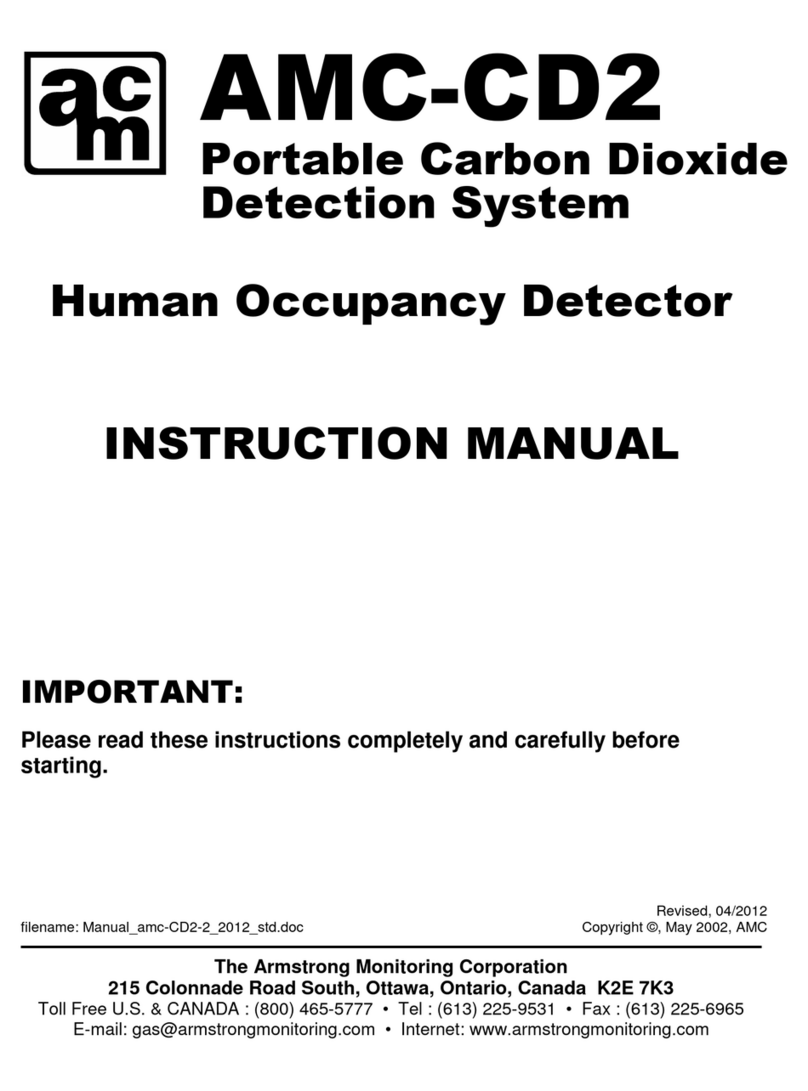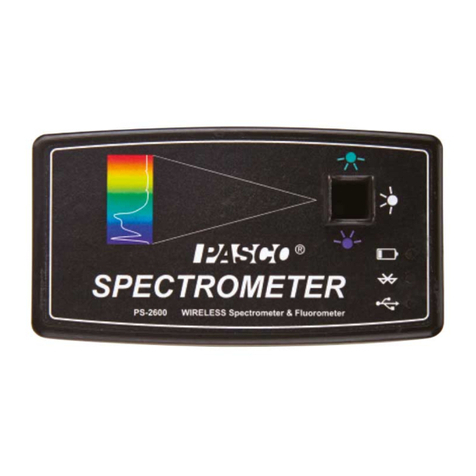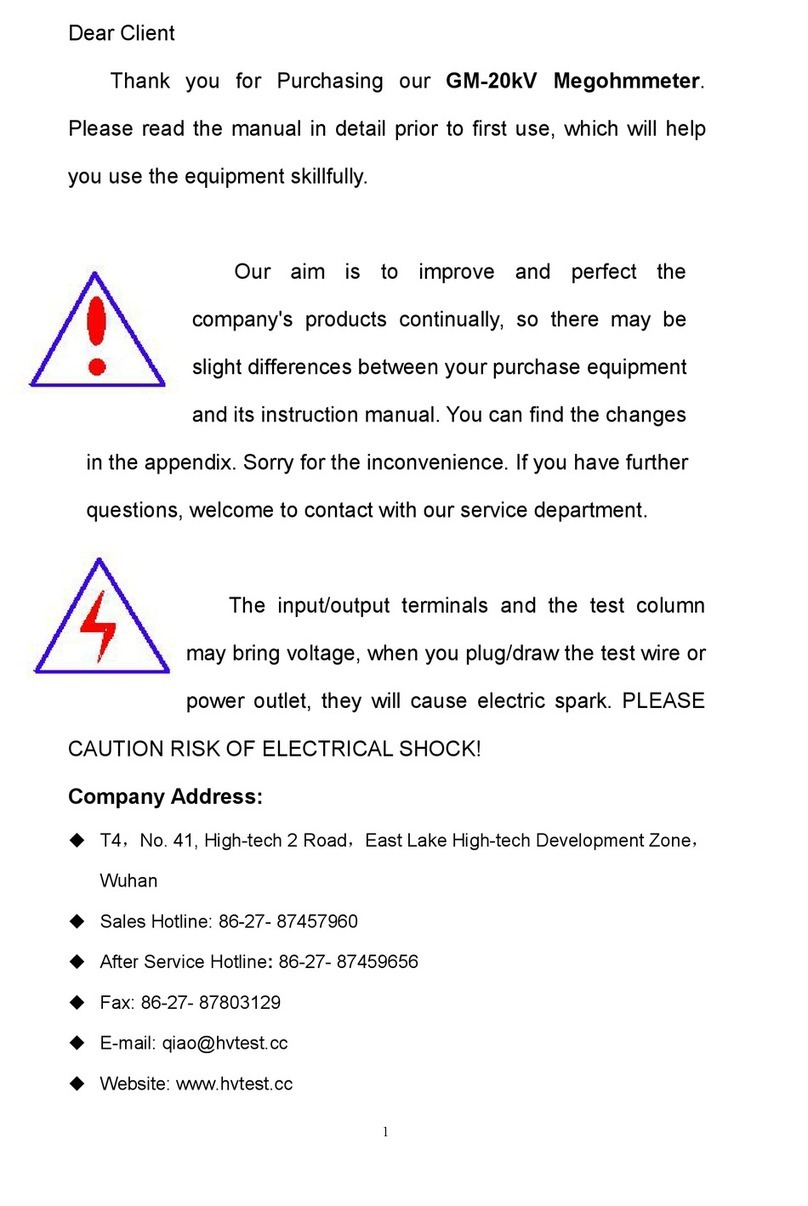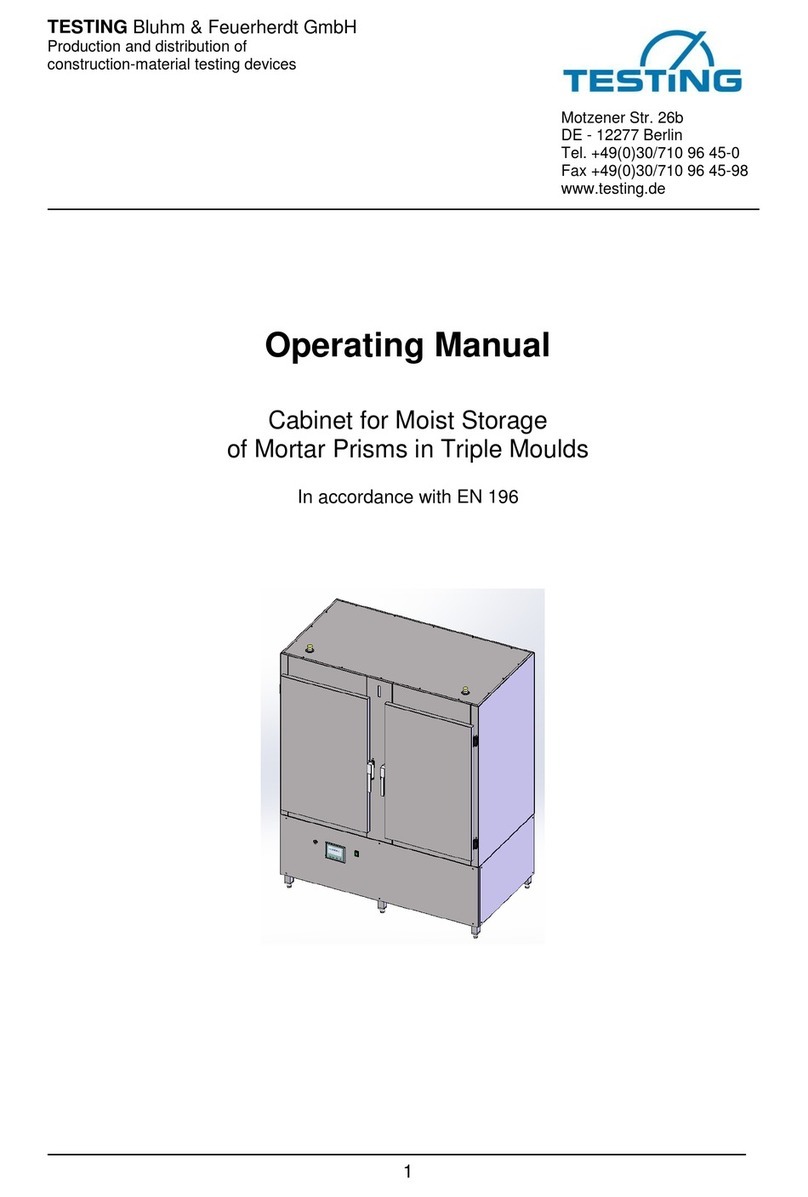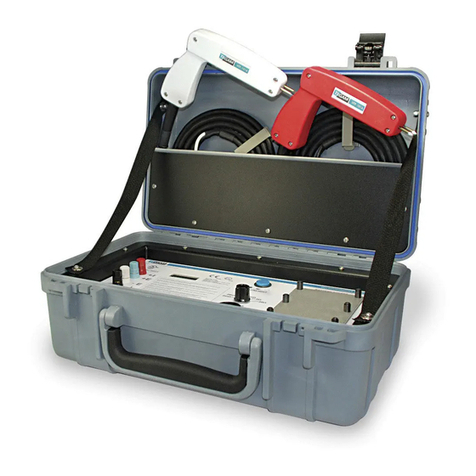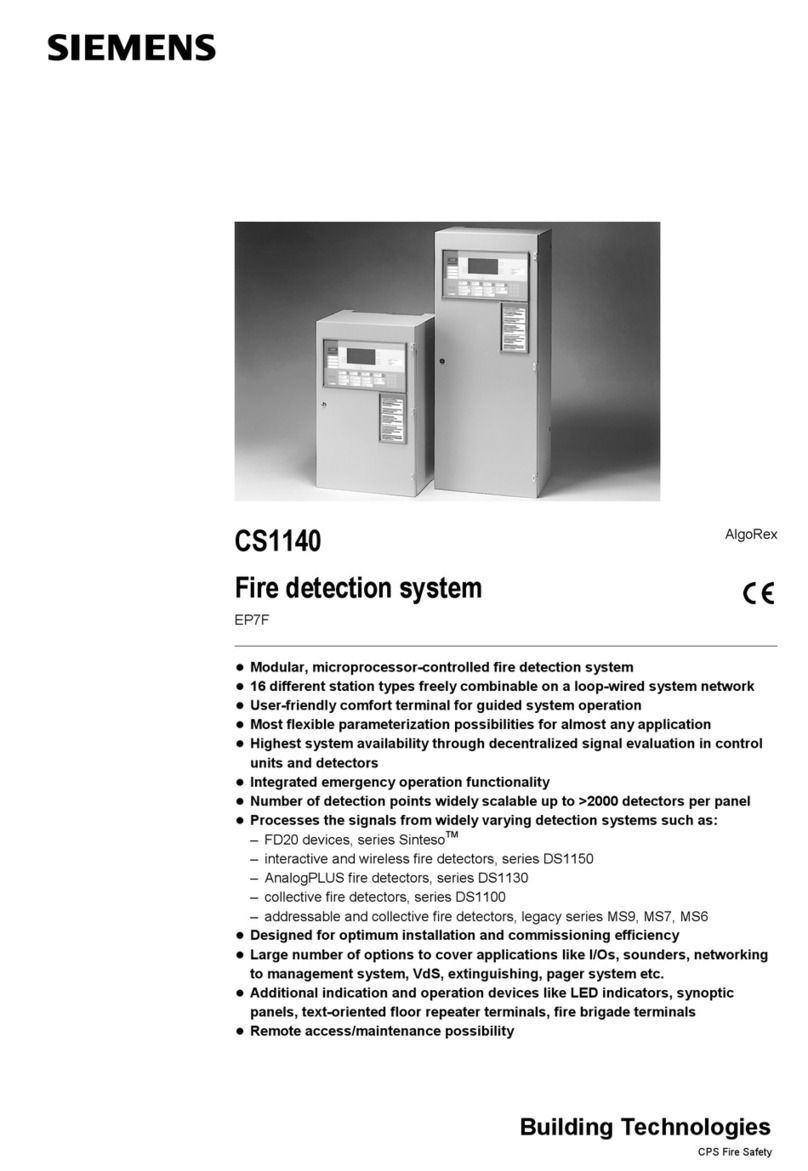Armstrong Monitoring Corporation AMC-310 User manual

310 AirSense
Infrared CO2Analyzer
INSTRUCTIONS
Installation & Operation of the
AMC-310 AirSense Infrared CO2Analyzer
IMPORTANT:
Please read these installation and operating instructions completely
and carefully before starting.
filename:
Manual_amc310_infrared CO2 analyzer.doc Revised, 7/16/2004
Copyright ©, Sept 2001, AMC
The Armstrong Monitoring Corporation
215 Colonnade Road South, Nepean, Ontario, Canada K2E 7K3
Tel: (613) 225-9531 • Fax: (613) 225-6965 • Canada & U.S. Toll Free: 1-800-465-5777


AMC-310 AirSense Infrared CO2Analyzer
1
TABLE OF CONTENTS
Section Title Page
1WARRANTY.............................................................................................................3
1.1 LIABILITY...........................................................................................................3
1.2 MODIFICATIONS AND SUBSTITUTIONS.........................................................3
1.3 PRODUCT RETURN .........................................................................................3
2PRODUCT INFORMATION......................................................................................4
2.1 ANALYZER........................................................................................................4
2.2 FACTORY CALIBRATION.................................................................................4
3PRODUCT DESCRIPTION ......................................................................................5
3.1 GENERAL DESCRIPTION.................................................................................5
3.1.1 ANALYZER DETAILS .............................................................................................5
3.2 Displays and Indicators......................................................................................6
4Installation...............................................................................................................7
4.1 Cover Removal ..................................................................................................7
4.2 Mounting ............................................................................................................7
4.3 Wiring.................................................................................................................8
4.3.1 Power Supply..........................................................................................................8
4.3.2 Signal Output...........................................................................................................9
4.3.3 Voltage....................................................................................................................9
4.3.4 Current ....................................................................................................................9
4.4 Verifying Voltage or Current Output Connection................................................9
4.5 Cover Replacement .........................................................................................10
5Field Adjustments.................................................................................................11
5.1 Analog Output Range Adjustment....................................................................11
5.2 Altitude Correction............................................................................................12
5.2.1 Altitude Correction Procedure...............................................................................12
6Calibration.............................................................................................................13
6.1 Verification Procedure......................................................................................13
6.2 High CO2Limit.................................................................................................13
6.2.1 Adjusting the High CO2Limit.................................................................................13
6.3 Optional High Limit Contact..............................................................................14
6.3.1 Setting High Limit Contact Polarity........................................................................14
7Duct Sampling Option..........................................................................................15
7.1 Overview..........................................................................................................15
7.1.1 Duct Kit Contents ..................................................................................................15
7.2 Duct Kit Installation ..........................................................................................16

AMC-310 AirSense Infrared CO2Analyzer
2
NOTE
This page intentionally left blank

AMC-310 AirSense Infrared CO2Analyzer
3
1WARRANTY
The AMC-310 AirSense Infrared CO2Analyzer is warranted against defects in material and
workmanship for a period of 18 months from date of shipment. During the warranty period, The
Armstrong Monitoring Corporation will repair or replace components that prove to be defective
in the opinion of AMC. We are not liable for auxiliary interfaced equipment, or consequential
damage. This warranty shall not apply to any product, which has been modified in any way,
which has been repaired by any other party other than a qualified technician or authorized AMC
representative, or when such failure is due to misuse or conditions of use.
1.1 LIABILITY
All AMC products must be installed and maintained according to instructions. Only qualified
technicians should install and maintain the equipment. AMC shall have no liability arising from
auxiliary interfaced equipment, for consequential damage, or the installation and operation of
this equipment. AMC shall have no liability for labour or freight costs, or any other costs or
charges in excess of the amount of the invoice for the products.
THIS WARRANTY IS IN LIEU OF ALL OTHER WARRANTIES, EXPRESSED OR IMPLIED,
AND SPECIFICALLY THE WARRANTIES OF MERCHANTABILITY AND FITNESS FOR A
PARTICULAR PURPOSE. THERE ARE NO WARRANTIES THAT EXTEND BEYOND THE
DESCRIPTION ON THE FACE THEREOF.
1.2 MODIFICATIONS AND SUBSTITUTIONS
Due to an ongoing development program, AMC reserves the right to substitute components and
change specifications at any time without incurring any obligations.
1.3 PRODUCT RETURN
All products returned for warranty service will be by prepaid freight and they will only be
accepted with a repair number issued by AMC. All products returned to the client will be freight
collect.
WARNING
USING ELECTRICALLY OPERATED EQUIPMENT NEAR GASOLINE, OR GASOLINE
VAPOURS MAY RESULT IN FIRE OR EXPLOSION, CAUSING PERSONAL INJURY AND
PROPERTY DAMAGE. CHECK TO ASSURE THE WORKING AREA IS FREE FROM
SUCH HAZARDS DURING INSTALLATION OR WHEN PERFORMING MAINTENANCE,
AND USE PROPER PRECAUTIONS.

AMC-310 AirSense Infrared CO2Analyzer
4
2PRODUCT INFORMATION
2.1 ANALYZER
Analyzer Unit Order Number ………………..……………….....
Analyzer Part Number …………………..……………..….…….
Analyzer Serial Number ….……………..…………..…….…….
Sensor Part Number …………………………..………….……..
Sensor Serial Number ………………………..………….………
Power Supply Requirement ………………..……………….….. 20 – 28 VAC or 18 – 30 VDC
Power Consumption ………………………………….…………. Less than 2W @ 24 VAC
2.2 FACTORY CALIBRATION
Gas Type …………………………………………………………. Carbon Dioxide (CO2)
Range ………….………………………………………….………
Zero Gas, at 4 mA signal ………………………………..………
Gas Concentration at 20 mA signal …………………..………..
Note:
All Armstrong Monitoring systems must be installed and maintained according to
instructions, to ensure proper operation. Only qualified technicians should install and
maintain the equipment.

AMC-310 AirSense Infrared CO2Analyzer
5
3PRODUCT DESCRIPTION
3.1 GENERAL DESCRIPTION
The AMC-310 AirSense is a non-dispersive infrared analyzer for measuring environmental CO2
concentration in ventilation systems and indoor living spaces. Its measurement range of
0 – 5000 ppm (parts per million; 1000 ppm = 0.1%) covers the range required to monitor
compliance with ASHRAE or other ventilation efficiency standards.
Packaged in a compact enclosure, the Model 310 can be discreetly installed anywhere from the
boardroom to the boiler room. Standard center wiring access and fully floating outputs make
installation a snap. The Model 310 provides several output alternatives. A voltage or 4 – 20 mA
current output is standard. An optional LCD readout is available. An optional relay contact can
be configured to open or close above a user-adjustable set point. A simple one-point calibration
procedure and a built-in calibration port that requires no special fittings or adapters make the
Model 310 simple to maintain.
3.1.1 ANALYZER DETAILS
OPERATING TEMPERATURE: 0 to 50 ºC (32 to 122 ºF)
OPERATING PRESSURE: Ambient atmospheric pressure.
HUMIDITY: 0 to 90% RH, non-condensing.
WARM-UP TIME: 3 minutes.
CALIBRATION VERIFICATION: 10 minutes (typical).
SIGNAL OUTPUT: 4 – 20 mA or 0 – 12 volts DC.
SENSOR TYPE: Diffusion or sample draws non-dispersive infrared (NDIR).
RESPONSE TIME: Less than 1 minute.
ACCURACY: ±5% of reading or ±75 ppm, whichever is greater.
REPEATABILITY: ±20 ppm.
TYPICAL DRIFT (per year): ±75 ppm (@ 1200 ppm).
LIFE EXPECTANCY: 10 years (typical).
Turn off power supply before removing or replacing the sensor/transmitter or sensor.

AMC-310 AirSense Infrared CO2Analyzer
6
3.2 Displays and Indicators
The basic Model 310 has a single green LED on the front panel which illuminates whenever the
unit is operating. This LED is on steadily when the measured concentration is below the high
CO2limit, and blinks whenever the concentration is above the limit.
The standard factory high limit is 1000 ppm, but can be easily adjusted in the field. The
procedure for adjusting the high CO2limit is described on page 13.
The display option adds a 4 digit liquid crystal display (LCD) to the front panel. The display
shows the measured CO2concentration in parts per million (ppm). 1000 parts per million
equals 0.1%.

AMC-310 AirSense Infrared CO2Analyzer
7
4Installation
4.1 Cover Removal
To open the Model 310 use a coin in the slot on the bottom to release the snap. Lift the cover
up slightly to disengage the closure and remove cover with a downward motion to clear the
catch at the top of the unit.
The locations of the controls and terminals on the main circuit board are shown in Figure 2 on
page 8.
4.2 Mounting
The Model 310 is designed for flush mounting with two fasteners. The locations of the mounting
points (shown in Figure 1) allow direct mounting on a standard simplex (single circuit) junction
box. There is a wiring cutout in the center of the unit near the terminal strips.
Figure 1: AirSense Model 310 Mounting Dimensions

AMC-310 AirSense Infrared CO2Analyzer
8
4.3 Wiring
This section describes the external connections to the Model 310. Wiring enters the chassis
through the cutout in the center of the unit.
4.3.1 Power Supply
The Model 310 will operate from an AC or DC input voltage between the values called out in the
specifications on page 4. The power supply leads are connected to the two-terminal power
connector shown in Figure 2.
The model 310 must never be connected directly to line power. Operation at voltages
higher than specified will damage the unit and void the warranty.
When operating from DC power, the polarity of the power leads must be as shown in Figure 2.
Reversed polarity connection will not damage the unit, but will make it inoperable until the
connection is reversed.
Figure 2: Model 310 Component Locations

AMC-310 AirSense Infrared CO2Analyzer
9
4.3.2 Signal Output
The Model 310 provides either a 0 – 10 volt or a 4 – 20 mA current loop output at the two
terminals of the analog output connector shown in Figure 2.
The type of analog output is determined by the setting of the analog output selector shown in
Figure 2.
The analog output of the Model 310 is completely isolated from the power supply. The common
outputs of multiple units can be connected together with no interaction regardless of power
supply hook-up. Refer to Figure 2 for Model 310 wiring connection to an AMC monitor.
4.3.3 Voltage
When the outboard and middle pins of the analog output selector are connected with the
shorting block, a voltage output appears between the two terminals marked ANALOG OUTPUT.
The output voltage increases linearly from 0 volts at the low output threshold to 10 volts at the
high output threshold. The unit is shipped from the factory with the low output threshold at 0
ppm and the high output threshold at 2000 ppm. See the Analog Output Range Adjustment
section on page 11 to change the analog output range limits.
4.3.4 Current
When the inboard and middle pins of the analog output selector are connected with the shorting
block, a current output appears between the two terminals marked ANALOG OUTPUT. The
output current increases linearly from 4 mA at the low output threshold to 20 mA at the high
output threshold. The unit is shipped from the factory with the low output threshold at 0 ppm
and the high output threshold at 2000 ppm. See the Analog Output Range Adjustment section
on page 11 to change the analog output range limits.
If the total resistance between the two terminals exceeds the specified maximum loop
resistance, the output current may be erroneously low at high concentrations.
4.4 Verifying Voltage or Current Output Connection
After the voltage or current output of the Model 310 is connected to a controller or indicator, the
following check should be performed to ensure that the connection has been properly
established and the Model 310 is transmitting the correct values:
1. Be sure that the output select jumper is set correctly for voltage or current output. If this
is not done first, the following check may produce incorrect results.
Note whether the shorting block at jumper JP5 is covering both pins or only a
single pin, then borrow the shorting block and slide it over the two pins of jumper JP4
(see Figure 2). The display (if present) will show ‘SEL’
2. Momentarily closing JP5 will set the unit to full scale output (10V or 20mA). Do not
press the buttons on the unit as this will affect the output calibration.
If the receiving device does not indicate a full scale reading after JP5 is closed, verify
that the wiring is correct.

AMC-310 AirSense Infrared CO2Analyzer
10
3. Remove the shorting block from JP4 and restore it to its original position at jumper JP5.
The Model 310 will reset and it’s output now corresponds to the actual detected CO2
concentration.
4.5 Cover Replacement
Engage the top center of the cover under the latch at the top of the base, then press the bottom
of the cover onto the base until it latches.

AMC-310 AirSense Infrared CO2Analyzer
11
5Field Adjustments
This section describes the features that can be field configured and the procedures to make
these changes.
5.1 Analog Output Range Adjustment
This section refers to advanced features of the Model 310.
2000 ppm users need not perform this adjustment.
The Model 310 ships from the factory set for an analog output range of 0 to 2000 ppm. This
range can be changed to any sub-range between 0 and 5000 ppm by changing two parameters:
The low output threshold is the concentration at which the analog output will begin to
rise. The factory default low output threshold value is 0.
The high output threshold is the concentration at which the analog output reaches its
maximum value. The factory default high output threshold value is 2000.
For example, a particular application may require the analog output to remain at 0V or 4.0 mA
until the gas concentration reaches 500 ppm, then reach 10V or 20 mA at a concentration of
1000 ppm. In this example the analog output would scale across this 500 ppm sub-range so
that the analog output would be at half scale (5V or 12 mA) at 750 ppm.
To change the analog output range use the following procedure:
1. Note whether the shorting block at jumper JP5 is covering both pins or only a single pin,
then borrow the shorting block and slide it over the two pins of jumper JP4 (see Figure 2
on page 8). The display (if present) will show ‘SEL’.
2. The display (if present) will show ‘SEL’. Momentarily closing a jumper selects which
value to change. If the wrong jumper is selected simply open JP4 to restart the unit and
begin again.
3. Select the low output threshold by momentarily closing JP1. If the display is present it
will show the current low display threshold. If there is no display the value can be
displayed using a meter connected to the analog output. In this calibration mode the
analog output is 10,000 ppm at full scale (i.e. 10.0 volts or 20.0 mA). If the voltage
output is selected, this scaling corresponds to 1 ppm per millivolt or 1000 ppm per volt.
4. Use the ‘UP’ and ‘DOWN’ buttons to adjust the low output threshold to the desired value.
In the example this would be set to 500.
5. Remove the shorting block from JP4 to save the value; the unit will reset itself.
6. Reconnect JP4. The display (if present) will show ‘SEL’. Select the high output
threshold by momentarily closing JP2. If present, the display will show the high output
threshold. If there is no display use a volt meter as described in step 3.

AMC-310 AirSense Infrared CO2Analyzer
12
7. Use the ‘UP’ and ‘DOWN’ buttons to adjust the high output threshold to the desired
value. In the example this would be set to 1000.
8. Remove the shorting block from JP4 and restore it to its original position at jumper JP5.
The Model 310 will reset and its output will now only change when the gas concentration
is within the range selected. Below this range the output remains low, above this range
the output remains high.
5.2 Altitude Correction
The Model 310 is factory-calibrated for operation at sea level. When operated at higher
elevations, the calibration must be adjusted by the amount shown in the altitude correction table
shown below.
ALTITUDE CORRECTION TABLE
Altitude (feet) 1.0 1.02 1.03 1.05 1.07 1.08 1.10 1.12 1.14 1.16 1.18
Multiplication Factor 0 500 1000 1500 2000 2500 3000 3500 4000 4500 5000
5.2.1 Altitude Correction Procedure
To adjust the calibration of a unit currently calibrated for sea level operation to a new altitude
proceed as follows:
1. Let the Model 310 stabilize to the ambient CO2concentration, and record the reading in
ppm.
2. Multiply the reading by the scale factor corresponding to the operating altitude in the
altitude correction table. For instance if the unit is operating at an altitude of 4000 ft, the
scale factor from the table is 1.14. If the concentration reads 420 ppm, multiply 420
times 1.14 giving 478 ppm. Adjust the display to read 480.
3. Remove the Model 310’s cover (see cover removal procedure on page 7).
4. Note whether the shorting block at jumper JP5 is covering both pins or only a single pin,
then borrow the shorting block and slide it over the two pins of jumper JP2 (see Figure 2
on page 5). Use the 'UP' and 'DOWN' buttons to change the concentration to the value
just calculated.
5. Remove the shorting block from jumper JP2 and return it to its previous position over
one or both pins of jumper JP5.
6. Replace the cover (see procedure on page 10).

AMC-310 AirSense Infrared CO2Analyzer
13
6Calibration
This section describes the calibration verification procedure and calibration adjustment
procedures.
6.1 Verification Procedure
A quick but approximate calibration verification can be done by supplying the unit with outside
air and letting the reading stabilize. CO2concentrations in outside air are typically between 350
and 450 ppm. A more accurate calibration check requires the use of calibration gas of known
concentration; a 1/8" I.D. flexible tube, regulator and calibration gas cylinder are needed. To
verify the Model 310's calibration, proceed as follows:
1. Remove the front cover of the unit (see procedure on page 7).
2. If there is no display on the unit being calibrated, connect a current or volt meter to the
analog output terminals. Check the setting of the analog output selector (see Figure 2
on page 8) to determine whether the unit is set for voltage or current output.
3. Note whether the shorting block at jumper JP5 is covering both pins or only a single pin,
then borrow the shorting block and slide it over both pins of jumper JP2 (see Figure 2 on
page 8).
4. Remove the dust cover from the calibration nipple, attach a flexible tube and establish a
flow of between 50 and 100 cc/min (0.1 to 0.2 SCFM) of calibration gas through the
sensor. Allow approximately two minutes for the reading to stabilize.
5. If the reading differs by more than ± 75 ppm from the known concentration of the
calibration gas, use the 'UP' and 'DOWN' buttons (see Figure 2 on page 8) to adjust the
reading.
6. When the reading agrees with the concentration of the calibration gas, remove the
shorting block on jumper JP2, and replace in its original position at jumper JP5.
7. Turn off the calibration gas flow, disconnect the gas tubing from the calibration nipple
and replace its dust cover. Remove the meter leads from the terminal strip and replace
the front cover (see procedure on page 10).
6.2 High CO2Limit
An adjustable high CO2limit is a standard feature of the model 310. The front panel LED
changes from steady to blinking when the indicated concentration is above the high CO2limit
value. An optional contact closure is available which opens or closes when the high limit is
exceeded.
6.2.1 Adjusting the High CO2Limit
The setpoint value is adjusted by closing jumper JP3 (see Figure 2 on page 8). If the display is
present when JP3 is closed it will show the current high limit setpoint in ppm CO2. If there is no

AMC-310 AirSense Infrared CO2Analyzer
14
display this setting can be adjusted by using a meter connected to the output. In this calibration
mode the analog output is 10,000 ppm at full scale (i.e. 10.0 volts or 20.0 mA). If the voltage
output is selected, this scaling corresponds to 1ppm per millivolt or 1 volt per 1000 ppm.
The setpoint is adjusted with the ‘UP’ and ‘DOWN’ buttons while JP3 is closed. When JP3 is
opened, the new relay setpoint takes effect and is stored in non-volatile memory. The setpoint
hysteresis is approximately 40 ppm.
6.3 Optional High Limit Contact
The high CO2limit option provides a dry (i.e. unpowered) contact closure that activates when
the detected concentration rises above the high CO2limit. The high limit is adjustable from 0 to
full scale of the unit.
6.3.1 Setting High Limit Contact Polarity
The polarity of the high limit contact is set with jumper JP5 as shown in the table below.
Jumper JP5 Relay Operation
OPEN normally closed
opens above setpoint
CLOSED
(factory default) normally open
closes above setpoint
To open jumper JP5 remove the shorting block from the two pins, and replace it so that it
engages only a single pin of the jumper. The shorting block should not be removed; it is
required during the calibration procedure.

AMC-310 AirSense Infrared CO2Analyzer
15
7Duct Sampling Option
7.1 Overview
The duct sampling option is used to divert a portion of the duct airflow through the Model 310.
The difference between the total pressure at the upstream sample port and the static pressure
at the downstream return port propels the sample stream. Minimum recommended flow rate is
200 feet per minute.
A Model 310 with the duct sample option has a sample draw adapter fitted to the bottom of its
enclosure. The duct probe assembly is connected to tubing nipples on the adapter.
Figure 3: Duct Sampling Schematic
7.1.1 Duct Kit Contents
1 dust filter 2 sheet metal screws
1 duct probe assembly 2 lengths of 1/8” ID tubing

AMC-310 AirSense Infrared CO2Analyzer
16
7.2 Duct Kit Installation
1. Select a point along the duct where the probe assembly can be installed into unrestricted
airflow without interfering with any internal duct components such as dampers, radiators,
etc.
2. Mark and drill the four holes for the duct probe as shown in Figure 4. The centerline
must be parallel to the air flow through the duct.
3. Install the duct probe assembly through the holes just drilled. The sample port must be
on the upstream side. Secure the probe assembly in place with the two sheet metal
screws.
4. Connect the open ends of the two tubes from the probe assembly to the two sample
ports on the base of the Model 310. It makes no difference which tube is connected to
which port on the Model 310.
Figure 4: Duct Probe Installation Dimensions
Table of contents
Other Armstrong Monitoring Corporation Measuring Instrument manuals
Popular Measuring Instrument manuals by other brands
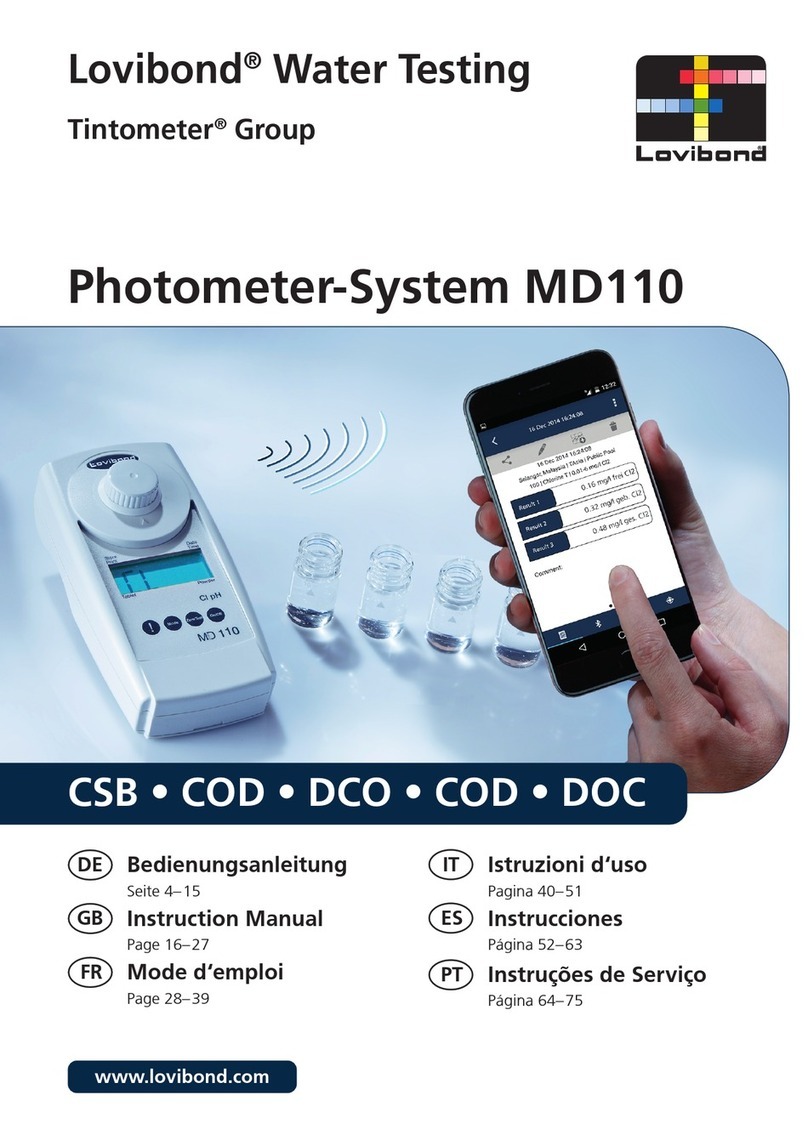
Tintometer
Tintometer Lovibond MD 110 instruction manual
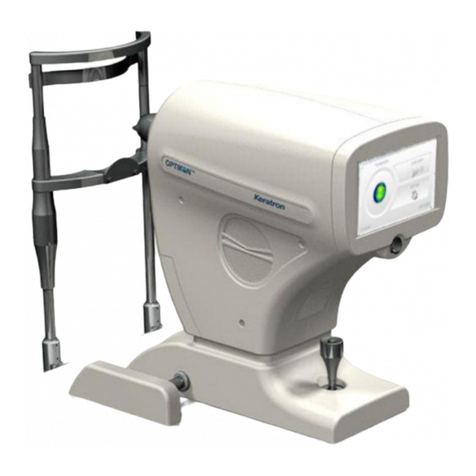
OPTIKON
OPTIKON KERATRON Installation and operating manual

EUTECH INSTRUMENTS
EUTECH INSTRUMENTS SODIUM GLASS instruction manual
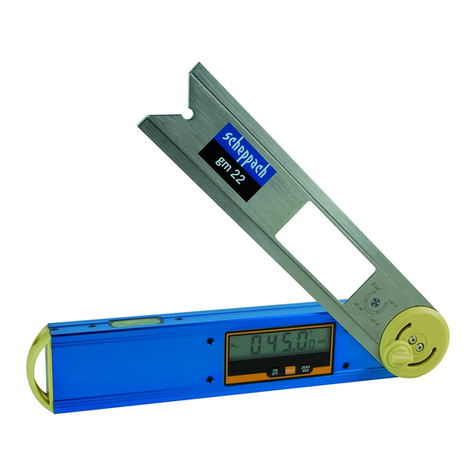
Scheppach
Scheppach gm 22 manual
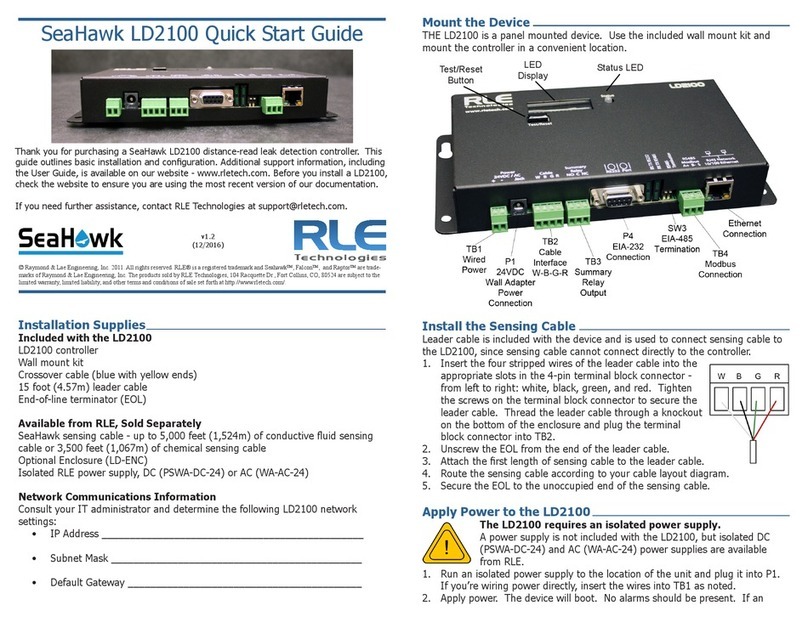
RLE
RLE SeaHawk LD2100 quick start guide
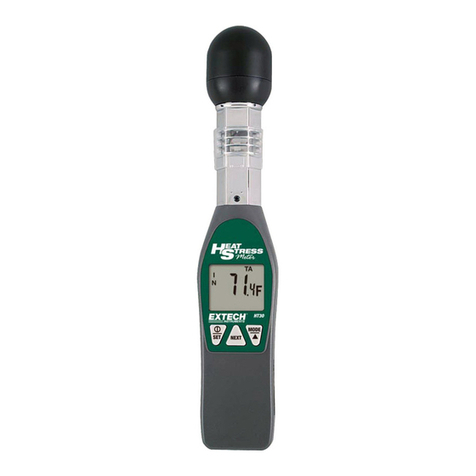
Extech Instruments
Extech Instruments HT30 user manual
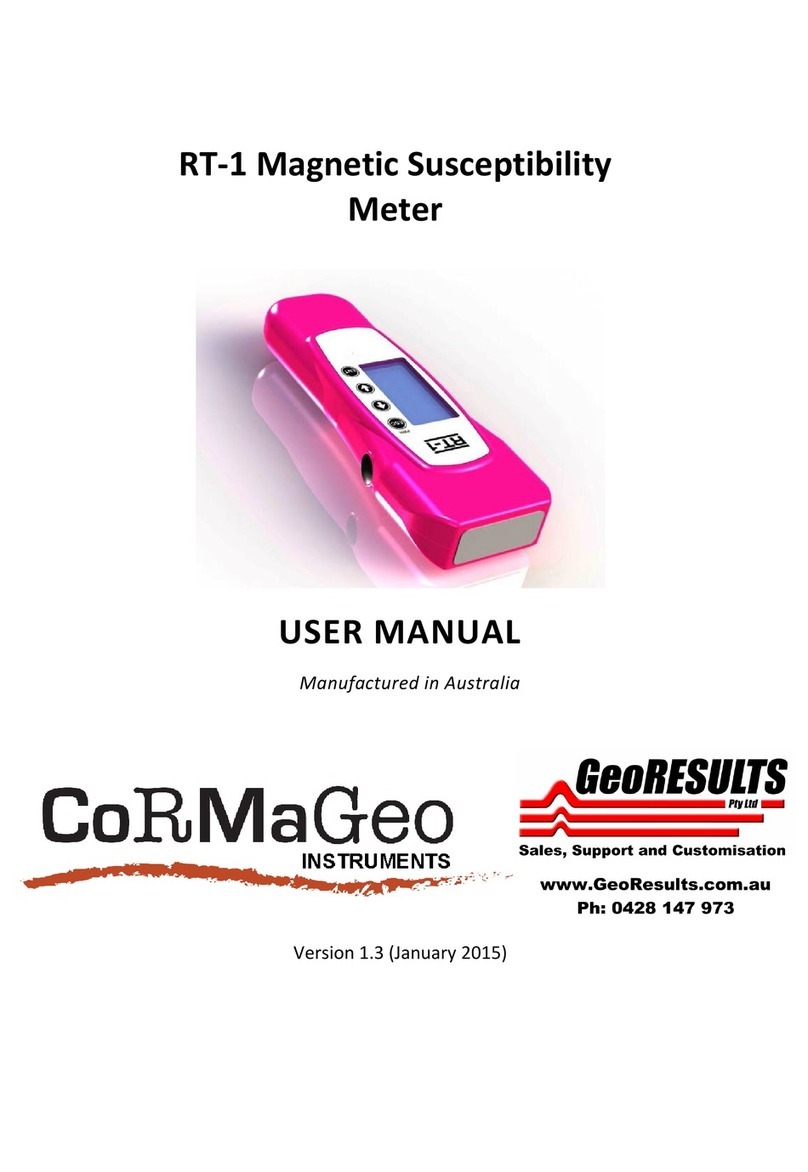
CoRMaGeo Instruments
CoRMaGeo Instruments RT-1 user manual
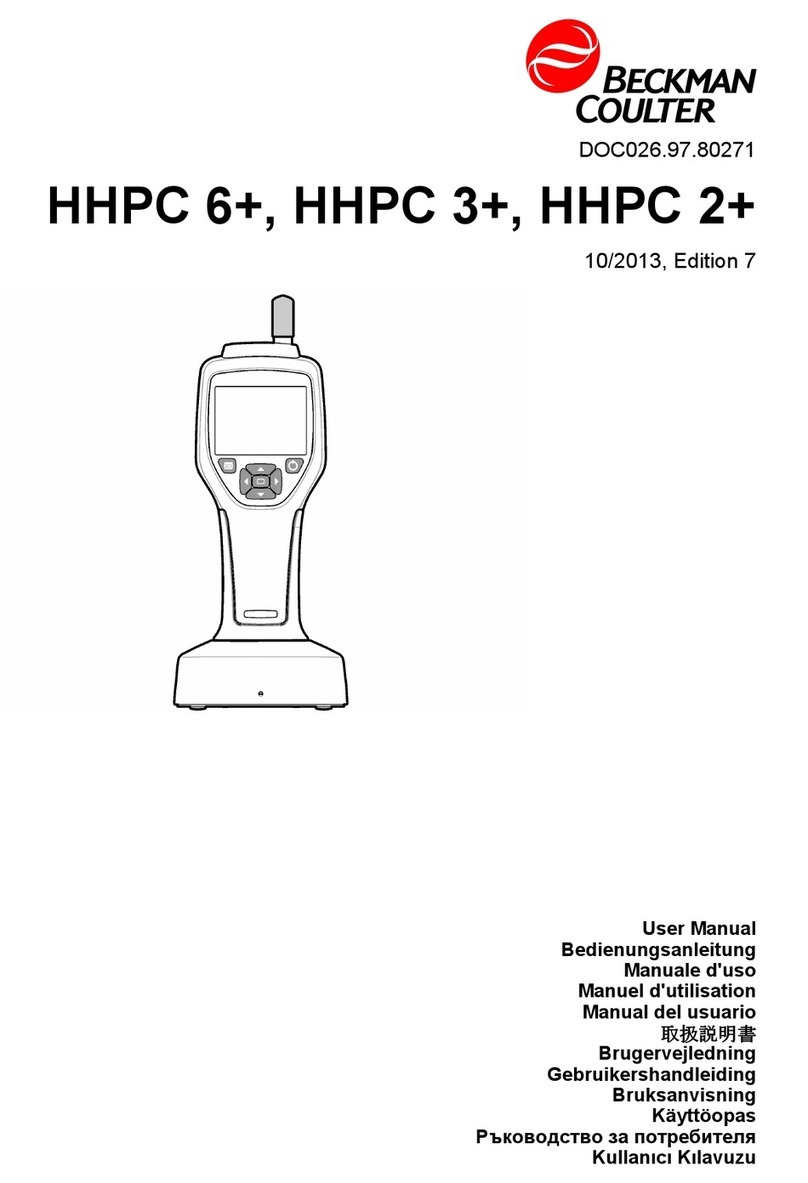
Beckman Coulter
Beckman Coulter HHPC 6+ user manual
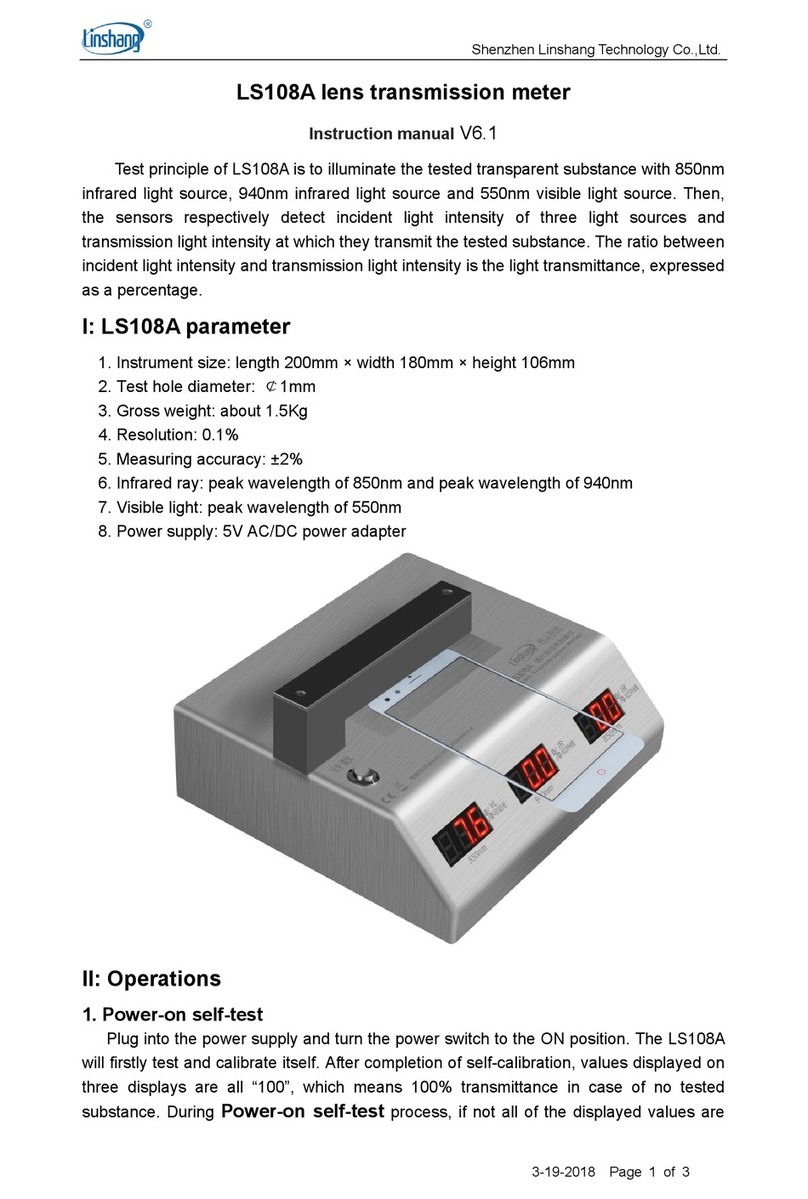
LINSHANG
LINSHANG LS108A instruction manual
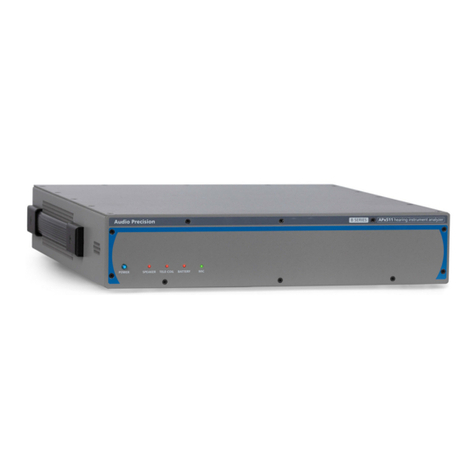
Audio Precision
Audio Precision B Series Installation Instructions, Specifications and Project Plans
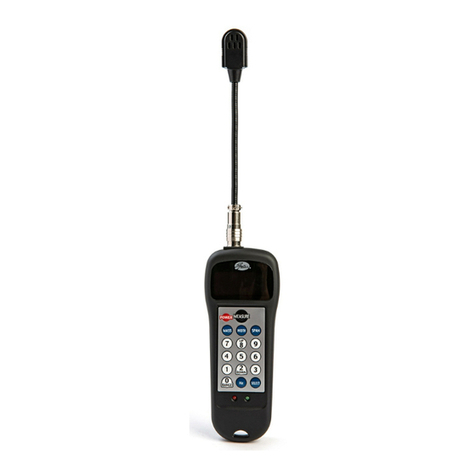
Gates
Gates 550C manual

Microlife
Microlife BP A150 AFIB manual
